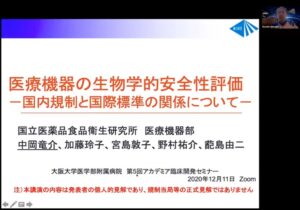(6th Seminar Report) Biological evaluation of medical devices for their market approval: How Japanese regulation and international standards are harmonized
On Friday, December 11, 2020, we welcomed Mr. Ryusuke Nakaoka from National Institute of Health Sciences, Division of Medical Devices for our 6th seminar. He gave us a lecture on the topic "Biological evaluation of medical devices for their market approval: How Japanese regulation and international standards are harmonized." Given the situation of COVID-19 infections, we held this seminar only online as before. Mr. Nakaoka also touched upon AI-based medical devices, which have become prevalent in recent years, and this seminar ended being filled with contents for one hour and a half.

Biosafety is a very important key in the development of medical devices. It is difficult to say that medical devices must be absolutely safe. So, he gave us clear explanations how to make a balance to assess the safe use of medical devices according to the following points in the lecture.
・ Biological safety evaluation of medical devices
・ International Trends and the Current State of Standardization (ISO/TC194).
・ National regulations (guidance) and JIS standards
・ Future development
Internationally accepted concepts and test methods exist for evaluation. At present, the standards established by ISO are reflected in the national regulations. In Europe, it appears these standards have almost always been incorporated into the European standards and are used in the regulations. Key parts in the United States seem to have been incorporated into the US standards and are used in regulations as well. If the developed medical device contacts body in any way, you will have to refer to the international standards by ISO/TC194 and you need to conduct a safety assessment, he explained.
Next, he talked about domestic regulations (guidance) and JIS standards. The contents of domestic guidance are close to the translated version of ISO 10993-1 called Part 1. And as a standardization in industry, which is one aspect of ISO, industry organizations revised the translated version of Part 1 without including the unique requirements in Japan and issued it as JIS T0993-1. JIS standardization of international standards in the field of medical devices has been promoted because it’s more convenient for industry if the national and international standards are the same when developing business abroad.
In the future, it will be important that how chemical analysis is applied for safety evaluation. It has become a global tide to use chemical analysis in biological safety evaluation from the viewpoint of animal welfare, and the trend will continue in the future. However, when biological safety evaluation by chemical analysis is carried out in practice, the assessment flow is very complicated, and the National Institute of Health Sciences is conducting discussions and research in an attempt to develop certain protocols. In addition, the National Institute of Health Sciences will introduce concerns, present conditions, and raise awareness in the future.
Finally, as the implementation of AI is progressing in the medical field and urgent countermeasures are required, he introduced a program conducted by the National Institute of Health Sciences including challenges and issues surrounding AI.
We appreciate that Mr. Nakaoka answered questions from participants in details, and we hope that this seminar was very useful especially for researchers considering expanding their research into business overseas.
We will continue to cover topics that will help researchers and invite leading lecturers in those fields. We look forward to your participation.


